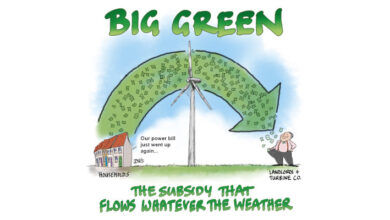Time to retire the term ‘renewable energy’ from serious discussion and energy policy directives

by Russell Schussler (Planning Engineer)
Part I: Renewable energy as a grouping lacks coherence
This series will look in depth at the inherent and emerging flaws within the renewable/nonrenewable framework for classifying generating energy resources. It may have made sense 50 years ago to speak in terms of renewable and non-renewable resources when thinking of future energy needs and plans. That basic conceptualization helped promote change and thinking about the impact of generation resources on the environment. But we are now far removed from the 1970’s. Current calls for major changes in the electric supply system, such as Net-Zero, envision sweeping change. Broad system efforts to address environmental concerns while meeting energy needs call for a more sophisticated understanding than can be supported by a dichotomy between “renewable” and “non-renewable” resources.
Neither “renewables” or “non-renewables” are coherent groupings for an energy resource typology. Similarities between resources in different groupings can be strong and within group differences can be large. Most statements made in reference to generic “renewables” are either trivial or misleading. Policy and legislation favoring renewables over other generation resources can encourage poor resource choices and hinder good resource alternatives.
It might be expected that those who are concerned about C02 emissions, those concerned about nuclear power, and those more broadly identifying with environmental movements might take exception with this proposal. But any serious proponents of net-zero or of major energy transitions should be in favor of more clarity and increased precision when undertaking serious discussions. Many environmentalists have grave concerns with expanded hydro and biomass-based generation, for example. This series will discuss later how “non-renewable” resources might be the cleanest and greenest proposals in many instances. Furthermore, the case against burning fossil fuels is more strongly made based on current environmental concerns, not based on fears that that such resources might run out hundreds of years from now.
Instead of speaking of renewables, let’s talk about how clean resources are, how green they might be, how sustainable they might be, and how well they work for supporting the needs of consumers and the power system. Let’s not lump resources which can be expanded with those that have limited future applicability. We shouldn’t confuse resources that support the grid with those that stress the grid, and pretend they have similar potential. For example, Iceland with abundant hydro and geothermal resources does not provide a renewable model to provide guidance and support for an area rich with wind and solar resources.
Renewable is a Relationship not an Independent Characteristic of Energy Sources
The UN defines Renewable energy as “energy derived from natural sources that are replenished at a higher rate than they are consumed.” Whether something is renewable or not, then is dependent upon the relationship between replenishment and consumption. Are wooden ships “renewable”? Yes and no. Forests in Ireland and Iceland provided “renewable” timber needed for ship building, until consumption increased much faster than the tree stocks could be renewed. Ship timber went from being a renewable resource to limited resources to a tragic environmental loss in a short time frame. At one point whale oil was a viable “renewable resource” which gave light to much of the western world. While many resources are “renewable” for a time, as usage increase their use may prove to be unsustainable.
Such relationships can be observed with present renewable energy sources as well. If you overbuild or over-dispatch generation relative to some geothermal resources, they can be exhausted. Similarly, the use of hydro resources can be depleted. Many areas have “water wars” where various constituencies fight over how water resources are used by recreational, agricultural, aquaculture, navigation and energy production. Past hydro energy usage patterns are not sustainable in many regions. Biomass generation, as did shipbuilding, can lead to resource depletion as well.
What about Non-renewable Resources?
Is the problem with nuclear, natural gas and coal, as suggested by the renewable/non-renewable dichotomy, that we may one day run out of these resources? Or are the concerns better focused on their potential impacts in nearer terms?
Nuclear power is generally not considered renewable. Nuclear waste purportedly could power the US for 100 years. Economically assessable uranium might last 200 years. With breeder reactors we may be able to generate with nuclear power for billions of years. Recognizing all the resources needed to produce electrical energy, based on our current technological abilities it looks like we could generate far more energy for longer time periods with nuclear resources before facing significant resource constraints than we might with renewable resources such as wind and solar. Sustainability based arguments against nuclear power are weak. Arguments against nuclear should be based on considerations beyond whether it is renewable or not.
Now let’s look at coal. The estimates for coal availability span 50 to 500 years or more. Those who oppose the use of coal want it sharply curtailed in the near term because of its environmental impact, not because they want to have it available for future use. Those who favor use of coal generally see coal as a bridge fuel and are not wedded to coal as a fuel choice beyond the life of existing and planned coal plants. Most importantly the arguments around coal use are not around issues of sustainability of supply, but rather the impact of coal plants today. Virtually no one’s position on coal use today will change based upon their understanding of whether we have 50 years or 3 million years of coal availability remaining.
Finally let’s consider natural gas. Because it is “cleaner” than coal, many see it as an excellent fuel choice to transition away from coal. Common estimates of natural gas availability fall between 60 and 120 years. This is far more natural gas than was assumed available before the advent of horizontal fracking. Again, even at the lower ends of availability, there is plenty of natural gas availability to allow for current natural gas facilities and significant future additions. Once again. overwhelmingly concerns around natural gas focus on the impacts of current fracking efforts and CO2 contributions, not the long-term availability of natural gas.
Resource Availability
Mankind depends on many resources for energy and other needs. Most all of these resources depending on demand, may become constrained. Does it make sense to set policies that consider resource availability hundreds of years in the future? As the saying goes, “It’s hard to predict, especially about the future.” If the thinking that dominated the renewable energy debate expanded into other areas, we would look at many resources very differently than we do now. WorldWatch says we could run out of iron ore by 2070. Projections for bauxite suggest it might only last for 25 to 200 years. Scientists from the Global Phosphorous Research initiative estimates that peak phosphorous will be reached by 2030. Gold mining may be uneconomically sustainable by 2050. Supply problems for cobalt may emerge in the next decade. Tungsten sources appear to be very limited. On the other side, it appears that we may have significantly more lithium than previously anticipated.
Many will argue that human ingenuity, changes in technology, alternative ways of doing things, alternative ways to capture resources and such will forestall any severe consequences from such forecasted resource depletions. So far, we have been good at coming up with solutions to anticipated resource problems. We had a close call with nitrogen a little over 100 years ago. Nitrogen for weapons and fertilizer were dependent upon reserves of bird guano built up over ages on remote islands. The supply was precariously dwindling, threatening to bring civilization to a halt. The Haber-Bosch process developed in Germany was able to draw nitrogen from the air and produce ammonia. Nitrogen from the ammonia could then supply the world. As an additional note – the initial process was dependent on osmium, an extremely rare element as a catalyst. Other catalysts and other processes have since been discovered, such that we are no longer dependent on osmium or the Haber-Bosch process. We should also be aware that today’s solution may be tomorrow’s problem. Instead of problems relating to dwindling nitrogen availability, abundant anthropogenic nitrogen creates environmental problems by supporting cyanobacteria and resultant algae blooms.
None of the above is to argue that we should glibly and wastefully use resources, ignoring potential future consequences. But neither should we dogmatically proclaim that resource depletion is just around the corner and that present trends cannot possibly persist. We have no real idea of any resource needs 100 years in the future. As we look at various generation resources ,the question of sustainability will always bring challenges. In considering competent alternatives it will be important to be as evenhanded as possible across resource types.
Sustainability Depends on the Entire Energy Conversion Process
Wind and solar appear not as constrained as some other renewable resources might, since we get fresh quantities daily. It is important though that we look not only upon the direct energy source, but at all resources needed to produce electric energy as well as the complete life-cycle impacts including construction, transportation and support services. To capture energy from wind and solar sources, we rely on many resources that are only available in limited amounts. It is arbitrary (and incorrect) to say that we only care about the renewability of the original energy source itself, and not the resources needed to convert the energy source to electric energy. If you are going to treat all potential resources fairly, it should be considered that the construction of vast solar and wind facilities can deplete critical resources, possibly making their increased use unsustainable. Current technologies do not allow for the replenishment in the foreseeable future of all the resources needed to convert wind and solar energy to electrical energy.
One may argue that wind and solar may not always be dependent on the limited resources that they rely on today, such as rare earth metals. That eventually through currently unknown technologies, they will be able to always meet power needs. As previously discussed, this is a perfectly reasonable hope. However, if you can make that argument, a similar one for nuclear fuel is likely even more well founded. Any dichotomy that places hydro, biomass, wind and solar as sustainable power sources, but sees nuclear power as being somehow less sustainable, should be considered suspect.
Does Renewable Mean Clean or Green? Should We Quickly Retire Non-Renewable Resources?
Environmental groups have been clear for years in their opposition to most all new hydro projects. Many environmental groups strongly oppose the Biomass industry, decrying the environmental impacts of our current approaches. FERC just approved the removal of four existing hydro resources based upon their continuing impacts. Geothermal plants release CO2 and most are carefully monitored to track emissions. Even wind and solar plants are not universally clean and green, as they can have particularly adverse impacts in some environments.
Many fossil fuel plants which could effectively provide backup power are imprudently retired to hasten a transition to support higher levels of renewables. This may provide aggregate numbers which look better to some, but this can be counter-productive. When considering lifecycle impacts of generation resources, retaining old plants for emergency service can be the most environmentally smart move available. Most environmental damage has already happened. Remaining incremental fuel impacts are small compared to the benefits. Considering CO2 alone, building extensive wind and solar or adding batteries to replace the emergency power that such units might provide, may have far greater adverse environmental impacts than prolonging limited fossil fuel generation.
The Line Between Renewable and Non-Renewable is Not Clear and Will Continue to Blur
Energy resources of the future may vary considerably from today’s expectations. It is likely that many might straddle the line between what is considered renewable and non-renewable. Existing technologies already blur the line. Molten salt cores are heated with mirrors to enable solar power to better match the grid capabilities of fossil fuel-based resources. As part of the process in some applications, the “renewable” solar resource was designed to burn supplemental natural gas to make the process more efficient. So far, such plants have not worked as well in practice as in theory. But they have provided hopes to many as a future synchronous “renewable” resource. If in fact they did work as planned, it might well make a lot of sense to be able to effectively tap a lot of solar power with the addition of a little natural gas, even if such a plant was not strictly “renewable”. Without careful attention to actual impacts, future clean plants which fall short of being strictly “renewable” may face undue hurdles.
Final Note
Speaking in terms of renewables and nonrenewable generating resources generally provides more confusion than clarity. Within-group differences are large in many cases. We can’t see the future and know what alternatives might emerge and prove successful. It is, however, clearly emerging that “renewable” and “nonrenewable” are dated terms who have outlived their usefulness. The next part of this series will look at how various generating resources impact the grid. Some “renewables” provide great support for the grid, while others create challenges. Lumping them together in discussion of grid impacts creates misunderstandings and problems that will long term harm any efforts to change the grid.




